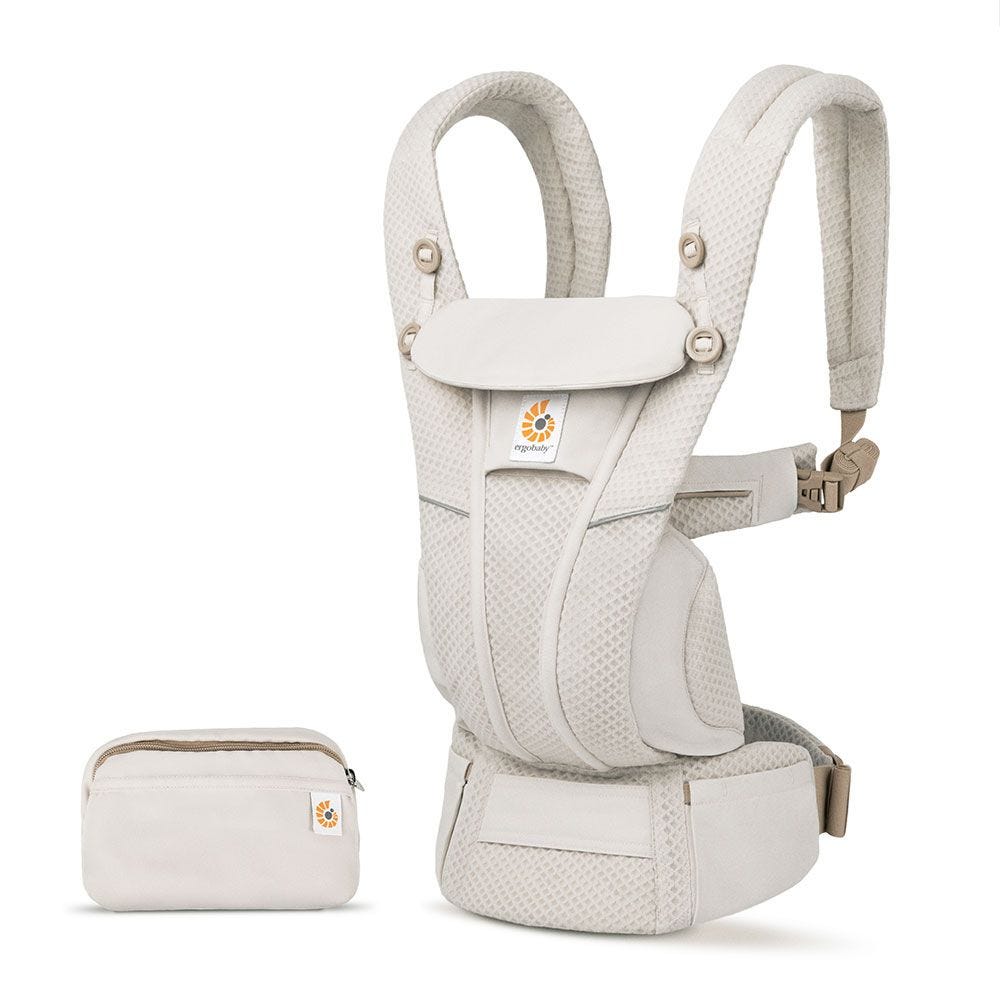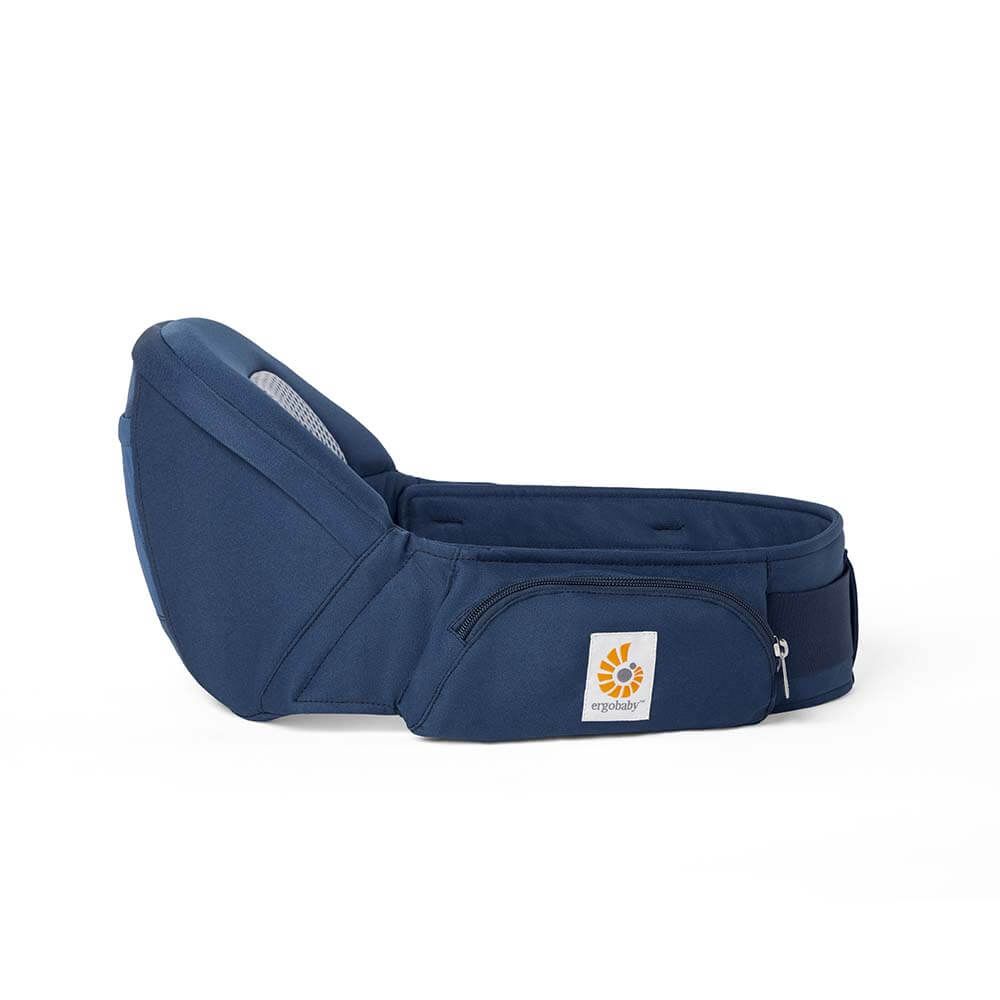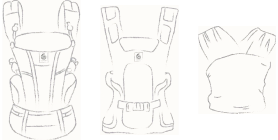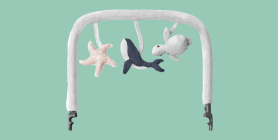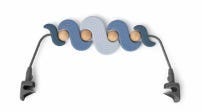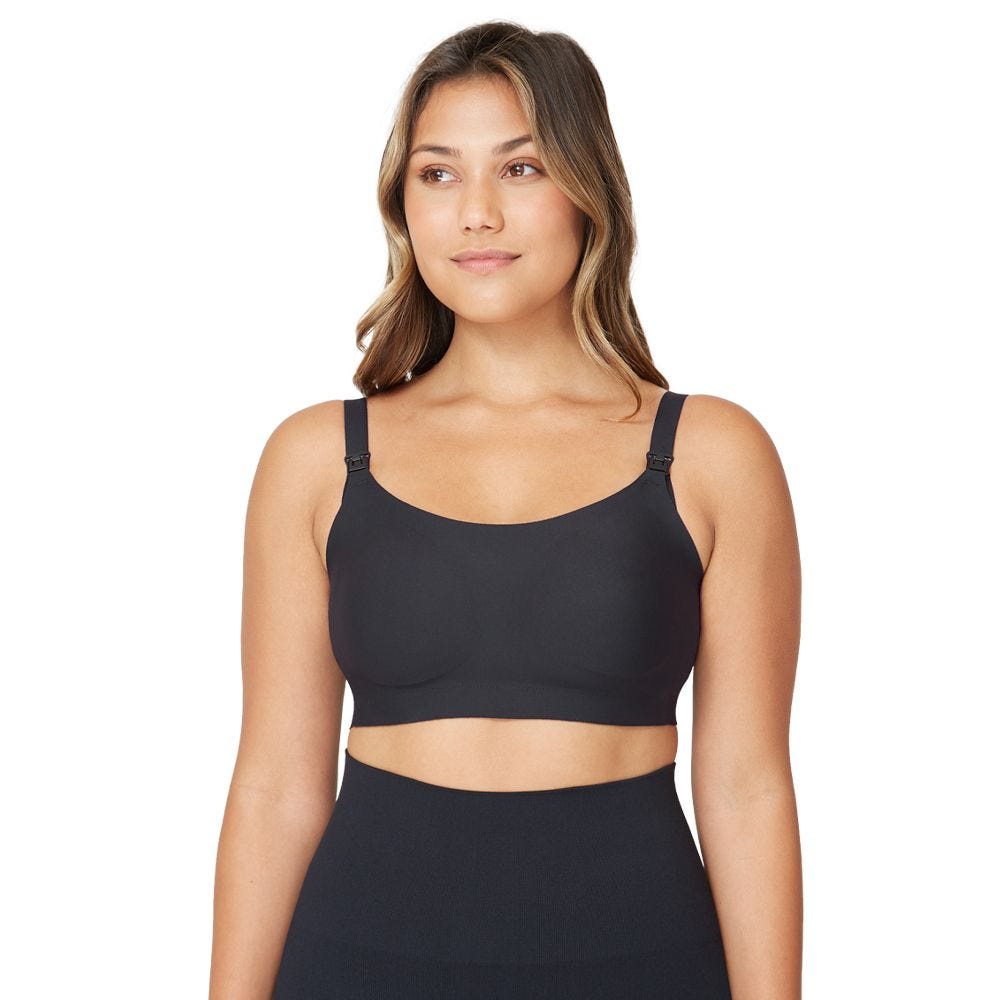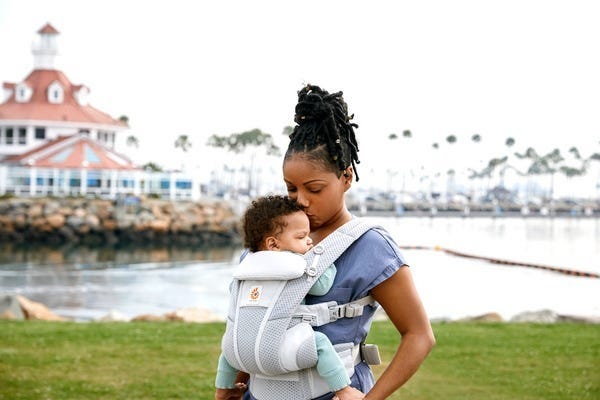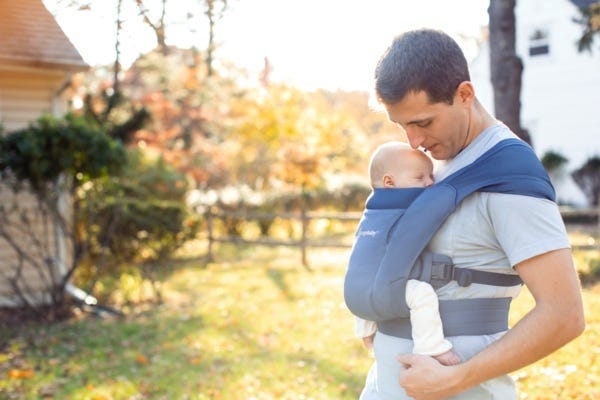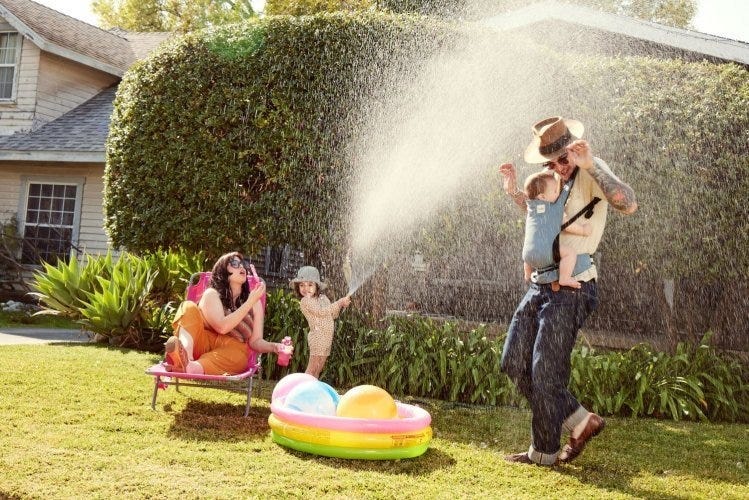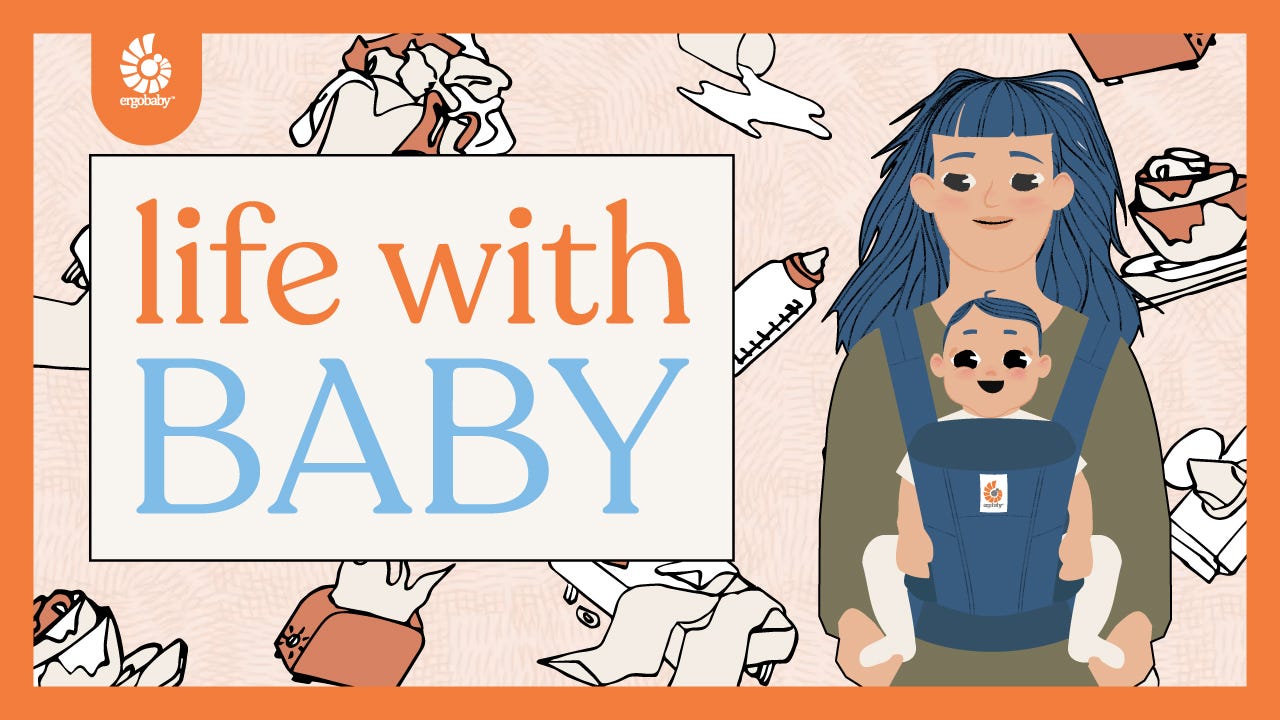
In the latest episode of the Life with Baby podcast we sit down with Brandi Jordan, the 'baby sleep fairy’ and doula to names like Rosamund Pike, Megan Fox, and Julia Stiles. We talk about how self-care is so much more than bubble baths, how to thrive in those tough early weeks of parenthood, and even navigating challenges in childbirth and advocacy. Brandi shares insights from her journey as a postpartum doula, lactation consultant, and pediatric sleep specialist, alongside heartwarming advice for new parents.
What We Discuss
(0:00) Introduction (2:08) What Exactly is a Doula? (3:35) The Unmatched Value of a Birth Doula (6:08) The Most Intense Birth Story Ever! (10:47) You Are in Control of Your Own Birth Memories (12:38) Motherhood vs. Social Media: The Real Struggle (15:52) Top Advice for New Moms (24:29) You Get WHAT Covered Internationally?! (27:29) Essential Postpartum Resources (30:53) Must-Have Product for New Parents (34:20) What Keeps You Up at Night? (37:58) Calm is Contagious (40:14) Takeaways
Resources + Show Notes
Ergobaby | ergobaby.com • instagram.com/ergobaby • tiktok.com/@ergobabyofficial Brandi Jordan| instagram.com/brandi_jordan_official • instagram.com/deardoulapodcast • thecradlecompany.com Carrot Insurance | get-carrot.com Dock-a-Tot |dockatot.com
Transcript
(0:00) Introduction
[Brandi Jordan] I've been several different people in this lifetime. [Brandi Sellerz-Jackson] And you're going to continue to shift and change. [Brandi Jordan] I hope so. Aren't you glad that you ain't the same person you were when you were 18? [Brandi Jordan] Oh my gosh, I was like, I am so glad I'm not my 24 year old self. And she was amazing, but she still had a lot to learn. [Brandi Sellerz-Jackson] That part. She was dope, but I'm glad. [Brandi Jordan] She was dope and she had abs, but. [Brandi Sellerz-Jackson] She was dope, she had abs and she had it going on. [Brandi Jordan] She had so much time. I don't know what she did with all the time that she had. [Brandi Sellerz-Jackson] She was working on her abs. That's what she was doing. [Brandi Jordan] Exactly. [Brandi Sellerz-Jackson] When Brandi Jordan was just 19, she knew she wanted to help women through labor. She found her calling as a doula. And now over 20 years and countless babies later, Brandi is an internationally recognized postpartum doula, social worker, lactation consultant, and pediatric sleep specialist with high-profile clients, such as Rosamond Pike, Megan Fox, and Julia Styles. She is the host of Dear Doula, a podcast supporting the early weeks and months of parenthood and the founder of the National Association of Birth Workers of Color. Brandi's goal is to help all moms, regardless of location or socioeconomic status, and to set them up to thrive once her time with them is complete. Brandi, welcome to the podcast. [Brandi Jordan] Hi. [Brandi Sellerz-Jackson] How goes it? [Brandi Jordan] Good. How are you? [Brandi Sellerz-Jackson] I'm good. [Brandi Jordan] First of all, thank you for such a nice, warm introduction. That person sounds amazing. [Brandi Sellerz-Jackson] Of course. [Brandi Jordan] I hope I can live up to what you just said. [Brandi Sellerz-Jackson] I mean, you are her. You're that girl. And I'm a little bit salty that I didn't know you when I had a newborn with all of my babies because, whew, the battle scars. [Brandi Jordan] I think we're probably having babies around the same time. So. [Brandi Sellerz-Jackson] Yeah, then it wouldn't have worked. [Brandi Jordan] I was on leave when you were on leave. We could have just commiserated through phone or something.
(2:08) What Exactly is a Doula?
[Brandi Sellerz-Jackson] We could of. Oh my gosh. Well, I think I want to start with the first question. What is a doula? [Brandi Jordan] I think it sounds like an easy question, but I will say a few things. I have mostly worked as a postpartum doula. For myself, that has meant providing support, sometimes prenatally, but definitely once parents come home from the hospital or after a home birth, helping them just to learn the ins and outs of caring for a new baby, but also making sure that the whole family is getting that kind of nurturing that they need, whether that's mom getting a cup of tea, dad learning how to give a bath, ushering in siblings to be a part of this new family unit. That's postpartum doulas. But most people, I think, are aware of birth doulas who provide actual emotional and physical support during the labor. They definitely usually meet with people before they have the baby to educate them on the process, to help them create their birth plan, to really shepherd them through. I always say it's hard to coach a sport that you haven't played, and so a doula really works as that coach for parents who haven't been through the process. With that being said, I myself have had three children and had a doula at all of my births, so it's definitely not just for first-time parents, but we really provide non-medical emotional support from you know conception through postpartum. [Brandi Sellerz-Jackson] That's so good that you said that, too. I love the part when you said you've had three babies, and you had a doula for all three. [Brandi Jordan] All three.
(3:35) The Unmatched Value of a Birth Doula
[Brandi Sellerz-Jackson] Can you express the reason for that? Because I think some people have this idea that, oh, I've already had a baby. I already know how this is going to pan out. It's like, oh, but do you? [Brandi Jordan] Yeah. I had been a doula for eight years before I had my first. As far as being versed, and I had been in plenty of births, I had done lots of postpartum, so I had quite a bit of experience for my first birth. With that being said, there's something about having that connected emotional support from someone who understands the process either as well as you do or better. For me, personally, having that connection of like, you know, we think about the red tent from back in Indigenous days. Having that as something that I explain to people is so invaluable. Just having someone kind of going through emotionally what it takes to bring a child into this world, however they come into the world, whether it's a belly birth or a vaginal birth, is something that you can't really put into words. You've experienced it. You know, having someone there who knew how to support my husband, how to help him support me, for me, was just a beautiful experience. It was a strength that I didn't know that I needed from someone else that has not filled me in each of the births. Some of the births, I had situations where we actually had to... I needed someone to advocate for me with the medical staff. You know, at this point, the situation I have with my last son, who's seven years old, I, at this point, had been in maternal child health field for 20 plus years, and I actually, emotionally, cognitively, did not have the ability to have these conversations. And so, thank goodness, my doula, my husband, were there to be able to talk through and to be able to support me because all I could focus my energy on was what I needed to do to get this child earthside. And so, I know people think about, like, belly balls and massage and, you know, someone grabbing your hips, but the spiritual, emotional piece of it is the thing that, actually, in those times of birth, we were just like, I don't know if I can give three more minutes. That person is the person that gives you the three minutes and the 30 seconds and the five minutes. And my husband would say the same, that, you know, it was as valuable for him as it was for me. [Brandi Sellerz-Jackson] Yeah, it's... I think people don't understand, too, like, the depths of that kind of support, having a doula there, that they're not just there for, you know, the birthing person, they're also there for the entire family that's there.
(6:08) The Most Intense Birth Story Ever!
[Brandi Sellerz-Jackson] Can you share with us one of your most harrowing birth experiences that you've assisted? [Brandi Jordan] Oh, I mean, I hate to say that there were so many, but there were so many. For those who are having children, first, can I just say this? Because I think there's a lot of talk, particularly in the past five years, about what it means to be a Black woman in birthing, and I am definitely a Black woman who has birthed three children. And so, before what I say, I want to be able to say that I birthed three children, I came home with three healthy children. I hope that they will hear that this is more likely to happen for them than what I'm about to say, because I definitely think that... I think we're doing people a disservice to only focus on the negativity when this is one of the most beautiful things that's ever going to happen to them… [Brandi Sellerz-Jackson] Absolutely. Yeah. [Brandi Jordan] When it happens how it should. And I think we deserve to have that as well, particularly, you know, the conversations that are happening around Black and Brown birth. So with that being said, I would say the most harrowing for me has been... I had a client, this is probably 12 years ago, who was doing really well, healthy woman, African-American. I had worked with them, I had done like multiple prenatal visits, like just a healthy, connected, like they did their childbirth classes, like everything about their process signaled they were ready to have this birth. From the moment we got to the hospital, it was just obstacle after obstacle. It's almost like they had to fight with people to deliver this baby. And if it was like, you know, the check-in person saying they didn't fill something outright, well, meanwhile, mom is trying to make it through contractions and they're being chastised about how they filled out paperwork. [Brandi Sellerz-Jackson] A contraction. I don't understand that, by the way, either. [Brandi Jordan] Like, if y'all don't get this paperwork, go do this tomorrow. Like... [Brandi Sellerz-Jackson] We can do this at some point, but just not right now. [Brandi Jordan] Not right now to this contraction. The anesthesiologist actually screamed at my client, yelled at my client, like basically chastised her because she was moving in a way that he didn't feel like she should be moving, so he chastised her. The dad was told several times that he was, you know, basically that his presence was making her more anxious, which doesn't even make sense. Like, that he should go take a breather. Now, he was very emotional about the way in which they were treating his wife, which was a valid and normal reaction. [Brandi Sellerz-Jackson] That checks out. That makes sense. [Brandi Jordan] They were gaslit to be told that it was, like, them causing this problem. Like, you're the reason why you're anxious. You're the reason why this is going the way that it's going. And then, subsequently, for 14 to 16 hours straight, they were bullied into having a cesarean. Her body was too small. She was too little. She didn't push well enough. Her baby was decelerating. Like, all the things that were happening were very normal things, but they definitely just got to a point where they wore them down to the point that they didn't even trust their own feeling about what was happening in her body, if that makes sense. And so, it wasn't one of the worst births as far as outcomes from what I've seen with clients, but I saw them break her spirit. You know what I mean? Like, she didn't even trust what she was feeling in her own body after 16 hours of someone telling you that you're not doing it right. You're not going to be able to do it. Your baby is, you know, you are making the decision to harm your baby. Like, it was that for 14 to 16 hours to the point where they were just like, do what you want to do. And basically, she had a cesarean to a very healthy baby and, you know, was kind of told, aren’t you so lucky you made the right decision not to harm your baby, you know? And so, I think for me, it was really harrowing because everything that was happening were things that were within the margins of normal. And so, there wasn't something where you could say, like, you did this and this was illegal or this wasn't like, you know, we could say, oh, that wasn't nice, but there wasn't a recourse. So, it felt, it had a helplessness to it that everyone felt and didn't know how to express. And for me, that was like, probably one of my more difficult births because I didn't really see a way that I as a doula in the situation that I could make it better for them. Like, at some point, you know, you know, our role as doulas anyway isn't for clients, to help clients make their decisions. It's to remind them of what they have said is important to them and what their wishes are, but I can't decide things for them. And so, in the end, my goal was to make them feel okay about whatever decision they were deciding to make, but I left feeling really defeated and defeated for them and just for women in general, who I know go through this, who have less resources, who don't have a doula, who, you know, might, instead of being told to leave a room, might be arrested for being too emotional at a hospital. And so, for me, that one stands out.
(10:47) You Are in Control of Your Own Birth Memories
[Brandi Sellerz-Jackson] Do you feel like that's something that happens a lot? Because I know there are so many parents that are probably up at night watching this as we speak, recounting and doubting themselves and thinking about, oh, I should have done this or should have, you know, they're “should’ve-ing” themselves, basically. What would you tell them in that moment? [Brandi Jordan] Oh, it's so hard because, you know, I work mostly in postpartum. I mostly do that now. I do some births here and there. And so, I'm usually seeing the aftermath of what's happened in the hospital. And so much, I'm feeling the defeat that people are feeling, like they failed, like they should have done something differently if I had just said this, if I had waited longer to go to the hospital. And so, what I usually tell parents is that they get the right to do that. They get the right to grieve that I wanted it to be this way instead of people telling me, you had a healthy baby, like that should be what you're focused on. [Brandi Sellerz-Jackson] That part. That part. [Brandi Jordan] You get to be able to say, this is not what I wanted. That I feel prodded and poked. I get to say that I want it to be a different way. I get to be unhappy, even though I have a healthy little one. And so, I validate those feelings for them, but also try to get them to remember the pieces of their birth story that they want to really be etched into their memory, into their soul, into the story they tell their child. Because usually for most people, there's something that someone said. It's having that first smell. It's the husband looking at his wife do something, or a couple seeing for the first time their babies you know cry. Getting them to remember those moments that they get to create that narrative for themselves and not let what happened continue to cloud the entire memory of what should be such a special event and time in their life. [Brandi Sellerz-Jackson] That's so good. And I know some, there's probably a lot of people that need to hear that.
(12:38) Motherhood vs. Social Media: The Real Struggle
[Brandi Sellerz-Jackson] Why do you think it's so hard for moms to take care of themselves? [Brandi Jordan] There's so many. [Brandi Sellerz-Jackson] And that is a loaded question. I know. [Brandi Jordan] Okay, so there's a couple. I think one, it's the socialization that's happened for most people, whether that is women or men, about what our roles are supposed to look like. And I think for many women or people who identify as women have maybe taken in this idea that we are supposed to be self-sacrificing, that the good of others, like that's part of being a good mom, being a good wife, being a good friend, is that we are selfless and giving of ourselves. And that's throughout the globe, not just like in the United States. But I also think, particularly now, there is a lot that people see, whether that's on social media or on television, that has painted this picture of women who have it all and that you can have it all. And I do believe that women can have it all. It might just be really messy. So I don't think that's what's portrayed on TV. They don't show that in the fine print, but I think a lot of people are trying to live up to a standard that they're seeing on Instagram or on TikTok of how their house is supposed to be cleaned and they're supposed to be doing dance routines and they should be having sex with their husband four times a week and all those things that just most people aren't doing that. But I think there's an expectation that has been created, particularly in the past, I want to say 10 years, that has made that the norm when it's really abnormal. We start to normalize so many things are abnormal. So I think it's a combination of what we grow up with as far as our roles. But also I think social media and TV plays a big role in that. [Brandi Sellerz-Jackson] Well, it's funny too. I think of, you know, I always tell people after having a baby, don't go on social media. Just stay off unless it's something that makes you feel good and it's a warm hug. Like if it's like watching a labradoodle snuggle with a baby, that is the cutest thing ever. But if it's anything else, stay off because you will see some of the most unrealistic things online. [Brandi Jordan] Yeah, I saw a woman doing headstands and she was like nine months pregnant. She was like walking doing these headstands and like showing her work. I was like, I can't do that if I was like 90 months postpartum, like it's not normal. [Brandi Sellerz-Jackson] I can't do it now. [Brandi Jordan] But I think there's just a lot that we normalize as being normal. And now this I do think is specific to the United States. Having lived in a couple of countries at this point, I think a lot, particularly self-care for North American based women. There is this idea that they have a kid and two weeks later they're at the office with the baby under their desk or they're doing work from the hospital room. That is a normal expectation where other countries they'd be like, are you insane? Like you're doing what? There, I think we've lost that reference that people are supposed to have downtime.
(15:52) Top Advice for New Moms
[Brandi Sellerz-Jackson] Yeah. What is the best piece of advice that you can give to moms? [Brandi Jordan] In regard to self-care, so this is actually one that I talk about a lot. I think that for me, one of the tragedies of, or can become a tragedy of motherhood, is that people believe that they have to stop being who they were before they had a child. [Brandi Sellerz-Jackson] Mmm, say that for the people in the back. [Brandi Jordan] Self-care is maintaining your identity outside of motherhood. To me is one of the biggest forms of self-care. I mean, I love my children. I adore my children. I love being a mom more than like so many things that I have accomplished and done in my life and will continue to do. However, I love my work. I love my girlfriends. I love traveling. I love doing things that aren't necessarily related to or involve my children. And I think the fact that I've had that and have maintained it has made motherhood so much more enjoyable for me. And I think that goes back to what you were saying about how we are socialized. I had the fortune that my mom is someone who kept her identity. I remember when we were kids. My mom would have times during the week or a day where we couldn't talk to her for like an hour. And so she basically, I think would lock herself in her bedroom. I remember knocking on her door and she'd be like, unless it's a fire. And even then, don't call me call the fireman. [Brandi Sellerz-Jackson] Is there a fire? Do you see a fire? [Brandi Jordan] Call 9-1-1 because I can't help either. But she literally would just like, [Brandi Sellerz-Jackson] I don't see flames. [Brandi Jordan] For lack of a better word, it was ignoring, but she took her time and did not feel guilty about taking that time. And so I was socialized that it was okay for me to have this time, that I was worthy of being able to do things that did not involve my children. To this day, I see my mom, she goes dancing twice a week. She does her thing and she maintained that through raising four girls. And so I think if I had to say anything about self-care is that part of that is keeping an identity that creates joy for you outside of motherhood and children because the other end of the spectrum, and I know a lot of my friends are going through this now because their children are now going to college and they're looking down the barrel of empty nesting at some point. And some of them are okay because they've maintained hobbies and a life for themselves outside of children. And some of them are not okay because so much of who they have been and how they measured their worthiness has been how they've showed up as mothers. And so self-care to me is doing the things that make you happy outside of your children because I think it actually makes you a better mother and you feel better as a person. [Brandi Sellerz-Jackson] Hundred percent. A hundred percent. And I think a lot of people miss that too because they think that saying, I need to have joy outside of my children. It almost feels blasphemous. [Brandi Jordan] Yeah. It feels. They have a lot of guilt about it. [Brandi Sellerz-Jackson] Right. It almost feels like, well, what do you mean? Yeah. They're supposed to be your all. And it's like, not really. Because one thing that's for certain is that these kids going to leave one day. They're going to leave out the house and they're going to be like, bye. And it's so important to have that identity that you speak of outside of them because they need to live their lives as you do too, you know? [Brandi Jordan] And if we're really thinking about our children, I think one of the greatest gifts we can give our children is not having the burden of our happiness. [Brandi Sellerz-Jackson] That part, I almost threw my coffee at the screen just now because it's a burden. That's exactly what it is. [Brandi Jordan] It’s a burden. So my academic training is as a clinical social worker. So I did work as a therapist for a little bit. And one of the things that came up often was a lot of the sadness, turmoil that people were feeling, a lot of that was due to what they felt their responsibility was to their loved ones. So many people were carrying so much hurt, so much, you know, feel like they've disappointed people because they weren't living up to the expectations of the people in their life that they want to feel proud of them. And so, you know, at this point when I was doing this work is before I had my own children. And I remember having that kind of thought of like, ah, how lucky have I been just as a person. I never had that for myself that my mom's happiness or, you know, my parents happiness was not relegated to how I was as a child. If I was, you know, behaved or misbehaved or whatever the case may be, like my mom's hopes and dreams were separate of mine. And I didn't understand how freeing that was until I was having people sitting in front of me who didn't have that freedom. [Brandi Sellerz-Jackson] That's so good, too, because I don't think many parents look at it as a burden. And it is, it really is, you know, to put that amount of weight on a child that, you know, or anyone, you know, that you make me happy. You are the source for my happiness, my fulfillment, my joy, my, you know, sense of purpose, even. I don't think anyone, especially our children, should have to carry that. [Brandi Jordan] I will say that, you know, in my time working as a therapist, when I worked as a social worker, I probably witnessed some of like the worst things you could see happen to children. You know, with that being said, I truly believe that 99.9% of the things that people do, they think they're doing it in the best interest of their children. [Brandi Sellerz-Jackson] A hundred percent. [Brandi Jordan] And I truly believe that. Like, I met so many people who did really terrible things who actually do really love their children. They might not have the tools to do it in a way that was right. And so I remind myself of that when, you know, for myself to give myself grace as well, that like most people are doing things with good intentions. But I think, like you're saying, that self-care piece, I take it really seriously because I know the impact that it could have for my children. I also am thinking like, my daughter's watching me, my sons are watching me. [Brandi Sellerz-Jackson] Yes, we're modeling it for them. [Brandi Jordan] And their expectations of themselves or their future partners, I want them to be very, very healthy ones. You know, we have a very non-traditional household in that, you know, me and my husband are very much a 50-50, like my husband does all the cooking. We kind of do, you do what you're good at, you know, in our home. I like how we decide. [Brandi Sellerz-Jackson] I love it. You’re good at that. That's your job. [Brandi Jordan] Yeah, like that. I have to like be clean in this or my husband has to be like, there is an expectation. I think I'm hoping for my children. It's going to allow them to decide, like what do they want to do? Like you want to be a stay-at-home dad? You want to be a stay-at-home mom? You want to be a working mom or working dad? Like they will feel comfortable feeling out whatever that is because they've been able to see us do that for ourselves. [Brandi Sellerz-Jackson] Yes. Yeah, and it's also too, you know, it's, you know, I always think too, not even what you're good at, but also what you care the most about. You clearly care more about this than I do. So it's your job. You know? [Brandi Jordan] Yeah, but I think it's these pieces of just, you know, owning what you need to make yourself happy and not making that someone else's responsibility. And that's not just for my career child. It's also for our partners and also being able to say if I need something from the people that are in my life that I love, but it's not that they, it's part of their job to ensure my happiness or my stability in life. And I think that a lot of parents do believe that this idea that like I'm spending all my time with my kids, like my whole life was on hold to get them from A to Z. The time factor, yes. I think that's so important. The quality of the time that you're spending with them, but the putting your identity, your life or whatever on hold, I think is one of the antitheses to self-care, particularly for mothers. [Brandi Sellerz-Jackson] Absolutely. I could not agree more. Could not agree more.
(24:29) You Get WHAT Covered Internationally?!
[Brandi Sellerz-Jackson] And you travel a lot. I mean, you're a world traveler. As a world traveler, can you share with us some of the things that you've noticed when it comes to postpartum? Because I think that's worthy of pointing out and it might make all of us want to move. [Brandi Jordan] And I know we're going to make the American clients and people in the United States cry. [Brandi Sellerz-Jackson] We're like, we're moving. We’re leaving. Bye. [Brandi Jordan] Like in Germany, you get 20 visits of a doula and that's covered through your insurance or through the government. And it's not just like you get this service if you're low income or you get this service if you are, you know, super wealthy, like everyone has access to this if they want it or they come, they check on you. Your midwife visits you at home, does home visits, they actually come to you. In France, where, you know, I spend a lot of my time now, postpartum, everyone gets what they call like basically your perineal re-education, you know, pelvic floor therapy that I know in the States, like it's like $400 a pop and mostly out of pocket. It's something that is part of- [Brandi Sellerz-Jackson] It's a luxury. [Brandi Jordan] No, it's part of what's standard for everyone to get six weeks after you go see the PT person and it's standard care. [Brandi Sellerz-Jackson] Absolutely. [Brandi Jordan] I have a friend who is in France and was having issues with infertility. Her IV was covered by public insurance, like covered. I have had clients who have mortgaged their homes in the United States to be able to do IVF. And not only was it covered, but the nurse actually came to the house to give her injections each week. So it's things like that that are just, you know, you don't have to worry about basic needs being met during your pregnancy or postpartum. And don't even get me started with child care and all those things that are just standard part of the fabric of the nation. I think it was Mandela that said like you can tell the fabric of a nation by how they treat their children. And so when you see the different subsidies that are available to families and children in a lot of the countries and not just Europe and Asia and some other parts as well that I've been to, there is the universal idea that every person deserves to have certain standard of care during their pregnancy and postpartum. So you don't see the similar divide in health care that we see in the United States based on like how much money you make, the kind of health care that you're going to get. Naturally, there isn't divide in these other countries because there definitely is if you can afford to have certain doctors or private care, et cetera. But generally you don't see so much of the have and have nots when it comes to health care. [Brandi Sellerz-Jackson] Well, maybe this will be the thing to get my husband to have another baby. If I say, hey, if we go to France, we got like a change of scenery, we got a vacation and we got a baby. [Brandi Jordan] Try a baby, get good health care, have some croissants, go hang out at the beach. Can't beat it. [Brandi Sellerz-Jackson] That part. I'm just here for the croissants and the baby. [Brandi Jordan] You know, and they're one of like the shorter paternity leaves here. I think it's only, only it's four to five months completely paid. I think you can get up to 70% at a year. But, you know, my friend who's my girlfriend's in Sweden, she got two years. [Brandi Sellerz-Jackson] Wow.
(27:29) Essential Postpartum Resources
[Brandi Sellerz-Jackson] What are some ways for us Americans here who may be trying to figure out the whole postpartum prenatal situation debacle that we have here? What are some resources that we can lean into? [Brandi Jordan] Well, so it's it's not all thorns. There's a lot of roses as well. In our system, in the United States system. And so I always like to point out that there's no perfect place. And so one of the things that I can say that I really loved about having my children in the United States that I feel that depending on the country that you're in, I think the idea of doing it naturally using a midwife, I think those things are. I would say they're very mainstream. Maybe some people don't think they are, but I think they're very mainstream and you have lots of accessibility to people who provide those services. Whereas in Europe, I know that people sometimes have difficulty finding a home birth, maybe one home birth midwife and a very one or two in a large city. And if they're in France, they take eight weeks vacation. So you have maybe slim pickings. So I think one of the things that people should feel happy about the United States, there's a lot of providers. I also think that postpartum, there's a lot more social support in the United States, meaning there's mommy and me classes. There are music classes you can go to. And not that you don't have these internationally, I just think that it's very much a part of the American experience that you're going to have your baby and get to go to this class and show them off and like, you know, take a picture at the end and see how much you guys have grown. I think it's just so built in that people feel very comfortable doing these things. But I would say as far as what you can latch onto, like right now, something that I'm seeing a lot of clients, you know, at our agency coming through with the Carrot insurance. I don’t know if you've heard about that. [Brandi Sellerz-Jackson] No, I haven't. Explain to us what that is. [Brandi Jordan] So Carrot is a supplement to insurance that you would get from your employer. It's basically a fertility and postpartum benefit, basically like your health insurance. But it's basically insurance for pregnancy and postpartum that lots of companies are starting to bring on. And we've had clients who called and said they have like, you know, a benefit of $20,000. Like it's not like they're getting $100. And just companies are starting to take on some of this responsibility of fixing that shortfall of care that pregnant people and families aren't getting. They are finding a way to do that. So if you are working for a company, ask them to get the Carrot benefit or you might have a company that has it. And so I would ask about that. But we are seeing clients are getting a lot of things reimbursed specific to their prenatal and postpartum care, paying for their midwife, paying for their doula, for their childbirth education classes. And it's all being covered by this insurance. [Brandi Sellerz-Jackson] That's so good. [Brandi Jordan] Also, a lot of state programs that are happening, I know in California through Medi-Cal and some other state sponsored programs where you're able to get your doula covered under state-sponsored insurance. [Brandi Sellerz-Jackson] Wow. [Brandi Jordan] You know those are resources regardless of your income that you're able to see if you are eligible for but I think more than anything I love this American idea of the community that we create if you don't have in your home. I think we're really good about creating that like by having classes and Facebook groups and all those other places that you can get that village if you don't have one naturally of your own. [Brandi Sellerz-Jackson] That's so good. Wow.
(30:53) Must-Have Product for New Parents
[Brandi Sellerz-Jackson] What is a must-have product for new parents? [Brandi Jordan] Oh we see I love products. I love products. [Brandi Sellerz-Jackson] I love products. Give me all the products. I like them. [Brandi Jordan] I like them. I'm like okay I want it all. No. [Brandi Sellerz-Jackson] I'll just say your top. [Brandi Jordan] My top. Okay so I love the Dock-A-Tot. I think everyone should have it. It's just so babies love it. It's basically just like a little docking station for your baby and now technically they're not supposed to sleep overnight in them. You know they're like you're on the sofa. They're hanging out and you're laying in your bed. They're hanging out. You're watching TV whatever but they love it because it gives them that cocoon feeling and they're also just very well-designed and gorgeous. So I tell everyone to have a Dock-A-Tot. I love white noise machines for babies, families in general. So I would probably say the hatch is another one that I'd want to have and it has a cool red nightlight on it as well and then some type of carrier. So if I had to say a carrier I mean I guess we have to say Ergo. [Brandi Sellerz-Jackson] I think so. [Brandi Jordan] I would have an Ergo but no I think you have to have a carrier like you know I wore all of my children. I had an Ergo for all of them. So I think having those is really important because I think for my husband for me like everyone used the Ergo like it was universal. We even had a little baby Ergo for my son that he put like a baby doll in which is super cute. [Brandi Sellerz-Jackson] Yes it's so cute. [Brandi Jordan] There's a picture of my daughter breastfeeding her baby doll inside the baby Ergo which is super cute. So those would be my three things. [Brandi Sellerz-Jackson] For me I mean a carrier was a must-have for sure. Even before I started you know working with Ergo but I know for me it allowed me to have some semblance of my humanness you know because it's like when you're in the depths of postpartum you kind of become enmeshed with this little person where I mean because all of their needs are you know solved by you. So it's just you know you're breastfeeding and you know and you're doing all these things and it's you haven't bathed in how many days and all of that and for me I feel like having an Ergo, a carrier, it allowed me to go and make myself some food. It allowed me to eat with both hands. It allowed me to wipe my butt. [Brandi Jordan] Right. It allowed me to start hiking again which felt really good. Like I remember my first hike back we used an Ergo. It got me back to doing things that I enjoyed for myself back to self-care. I love hiking. Me and my husband love hiking together and separately and so having a carrier was one of the things that allowed me to get back feeling like myself in my body which was really important. [Brandi Sellerz-Jackson] So important.
(34:20) What Keeps You Up at Night?
[Brandi Sellerz-Jackson] I have one more question. Actually, I have two questions. One, what keeps you up at night? [Brandi Jordan] Oh how much time do we have? So many things keep me up at night. The state of the world keeps me up at night a lot. It often feels like we're fighting so many different so many different fights on so many different fronts it doesn't it often feels like you're not sure where to begin. There's so many things happening in the world at one time that it sometimes feels hard to take a stand or to show up in a way that I feel like I'm supporting my community because it can often feel overwhelming in the sense of helplessness that you just can't fix everything and so what does that mean for our children? So that's probably one of the bigger things that keep me up at night. I think for myself and just something that's me, I want to make an impact and so there's always this idea like am I doing what my personal purpose is you know in my work with my family you know for my ancestors like am I going to make the kind of impact and legacy that my ancestors would feel proud of or feel like what they went through and what they endured was worthy of what I have created in my lifetime is something that is very near and dear to my heart and my soul. [Brandi Sellerz-Jackson] I can say right now you are. Let me say that you are the work that you do I believe that it honors them and the way you take care you know I always say like how we take care of ourselves and nurture ourselves and rest that's how we honor those who before us and who couldn't rest. [Brandi Jordan] Yeah, so it's funny that you say that. Yeah, because this is something I didn't know when I became a doula. So, my great-grandmother, her name was Magnolia. I did know her growing up, and my daughter is named Magnolia after my grandmother. We called her Nola, so we also called my daughter Nola. She died when I was like 10 or 11, so I grew up knowing my great-grandparents. I didn't know that her mom died giving birth to her. I didn't know that about her story, and I also didn't know, now this is just black people stuff because we come in all colors, I didn't know that my grandmother was biracial. Yeah, so I was like, "We come in all colors. Yeah, you didn't know?" I was like, "Mom, we come in all colors." Why would I ask that question? I was literally like 30-something years old, and I was just like, “What?" But okay, so my family is from my mom's family in Mississippi. Given the time frame, you know that would have either been illegal, you know, an illegal love affair or something that wasn't a love affair and was actually illegal, and not you know, we don't know what the nature is of their relationship. But I think about what she endured and what her mother deserved, and that I get to help create that for other women. That's part of my legacy. Now, the not funny part of the story, but the irony of the story, is that my dad's mother, who just passed this past July at 102, I know a lot about her story, and her mother died in childbirth as well, birthing triplets. So, to have had these two stories happen on both sides of my family and for me to be doing this work, I’m always validated that I'm in the right space. [Brandi Sellerz-Jackson] Yup, Yup you're absolutely in the right space. [Brandi Jordan] But it feels so special and so um so much gratitude for it that it feels like there's a lot to make up for that sacrifice. [Brandi Sellerz-Jackson] Yes.
(37:58) Calm is Contagious
[Brandi Sellerz-Jackson] All right last question, there are more than likely a parent there's a parent up at night right now pacing the floor, and they're probably trying to get their baby to sleep right now, and they're probably a little stressed, just a little bit. What would you tell them in this moment? [Brandi Jordan] That they're doing a great job, that this too shall pass, that just when you think that this is the worst it can get, it's going to change. It's going to get better, you're going to get great at it, and then it's going to change again. But one thing that I always say with my clients I talk alot about this, is that calm is contagious, and the energy of parenting. So much of what happens, and I do believe this, I do believe that our children picked us. Everything about you, even the flaws and all the mistakes you think you're making, is part of what your child wanted on their journey. So just know that you are the perfect person to be making those mistakes with your child because that's what they have asked for in this lifetime. But I also would say to give themselves grace, the same kind of grace they want their child to give themselves. And to be reminded in that energy of parenting, when you expect the best to happen, that you expect the best for yourself, that you expect the best outcome. It often times will work out in that way, and when it doesn't, it's not the end of the world, and this too shall pass. [Brandi Sellerz-Jackson] That calm is contagious part. That right there is so good. [Brandi Jordan] It's true. Parents ask me all the time about that like why they did that like this is how I came up with that so basically they would be like oh I did this and like when I do it it's the exact opposite but when you do it they just lay down or they just stop crying or they just whatever. And I just kind of told them like it's not what I'm doing it's what I'm feeling; what I'm thinking. And I know that might sound rude to people but they pick up on that sense of confidence, they pick up on that state of calm, and they respond to that not exactly what I'm doing. Which is why you can do what I do step-by-step and not have the same outcome. [Brandi Sellerz-Jackson] Thank you so much Brandi. We appreciate you. [Brandi Jordan] Thank you for having me. [Brandi Sellerz-Jackson] And we're so honored that you sat and talked with us today. Thank you all for listening and we hope that info shared, the word shared, has made your life has made your life with baby a little bit easier.
(40:14) Takeaways
[Brandi Sellerz-Jackson] All right, so that was a really insightful episode. My takeaway was how she made self-care a little bit more practical. That it's not just relegated to baths and massages but is more so an active decision to remain tethered to ourselves and our identity as an individual, as a person outside of our little one. That was one thing. Another thing that stuck out was that it's okay to find joy outside of our children. That's something that I hear so much as a doula and as a parent as well, that our kids are supposed to be our world. Another thing that stuck out to me was how vastly different the U.S. is from other countries in supporting parents. It made me want to pack my bags and to move. Another thing that stuck out for me is that you are the perfect parent for your little one. In all of your trying to figure it out and make sense of this mess and chaos that is parenthood, you are the perfect parent for your children. They picked you, and that for me, I feel like that's what I should leave you on today. That stuck out for me. My takeaway was how she made self-care a little bit more practical. That it's not just relegated to baths and massages, but it's more so an active decision to remain tethered to ourselves and our identity as an individual, as a person outside of our little one. That was one thing. Another thing that stuck out was that it's okay to find joy outside of our children. That's something that I hear so much as a doula, as a parent as well, that our kids are supposed to be our world. Another thing that stuck out to me was how vastly different the U.S. is from other countries and supporting parents. It made me want to pack my bags and to move. Another thing that stuck out for me, that you are the perfect parent for your little one. That in all of your trying to figure it out and make sense of this mess and chaos that is parenthood, you are the perfect parent for your children. They picked you. And that for me, I feel like that's what I should leave you on today. That stuck out for me. Ergo Baby is dedicated to building a global community of confident parents. The Life of Baby podcast is just one of many ways we hope to support parents through all the joys and jobs of parenting. This podcast was produced by Tiffany Toby, consulting producer Anthony Gannon, edited by Angel Hunter and Hannah Richardson Speckart, written by Vittoria Allen, sound design and theme song by John Jackson. Graphics designed by Noah Friedenberg and our executive producers are Christina Solletti and Kalani Robinson. And I am your host, Brandi Sellerz-Jackson.
Emotional Benefits of Getting Outside
Spending time in nature with your baby can strengthen the bond between you. The simple act of holding your baby close, feeling their warmth, and sharing new experiences together can create strong emotional connections. It’s also a wonderful way to reduce stress and improve your mood. When my littles were extra fussy, I’d take a walk around the neighborhood. Even though I don't live in an area with trails and surrounded by nature, simply behind outside changed everything. A little vitamin D does wonders!
Cognitive Development
Nature is a sensory wonderland for babies. The different sights, sounds, and smells can stimulate your baby’s senses and promote cognitive development. Watching leaves rustle, hearing birds chirp, and feeling the texture of a tree bark can all contribute to their learning and development.
All About Baby Carriers for Nature Adventures
Choosing the Right Baby Carrier
When it comes to selecting the best baby carrier for summer adventures, there are several options to consider.
Types of Baby Carriers:
- Wraps: Perfect for newborns, providing a snug and secure fit.
- Slings: Ideal for quick and easy use, offering good ventilation.
- Soft Structured Carriers: Versatile and comfortable for both parent and baby, suitable for longer trips.
Factors to Consider:
- Baby’s Age and Weight: Ensure the carrier is appropriate for your baby’s size and weight. For example, Ergobaby’s Embrace Newborn Carrier is perfect for the fourth trimester where baby is small and you’re looking for an easy way to stay close. As they grow, you’ll want to upgrade to an all-position carrier that’s meant for growing babies.
- Parent’s Comfort and Ergonomics: Look for carriers with padded shoulder straps and lumbar support if you’re planning on longer outings.
- Ease of Use: Choose a carrier that is easy to put on and take off.
- Climate and Breathability: Opt for carriers made of breathable fabrics to keep you and your baby cool in hot weather.
Safety Tips:
- Proper Positioning: Ensure your baby is seated correctly, with their legs in an "M" position and their head should be close enough to kiss.
- Checking for Wear and Tear: Regularly inspect your carrier for any signs of damage.
- Ensuring Adequate Support: Make sure the carrier provides proper support for your baby’s head and neck.
Exploring Nature with a Baby Carrier
Ideal Spots for a Nature Walk with Baby
- Parks and Gardens: Great for leisurely walks and picnics.
- Nature Trails and Forests: Perfect for more adventurous outings.
- Beaches and Lakesides: Wonderful for enjoying the water and sand, with the right carrier.
Activity Ideas
- Hiking: Enjoy a scenic hike with a hiking baby carrier that offers support and storage.
- Bird Watching: Use your carrier to keep your baby close while you explore and observe wildlife.
- Picnics: A carrier can free up your hands, making it easier to carry picnic supplies.


Advantages of Using Strollers for Nature Adventures
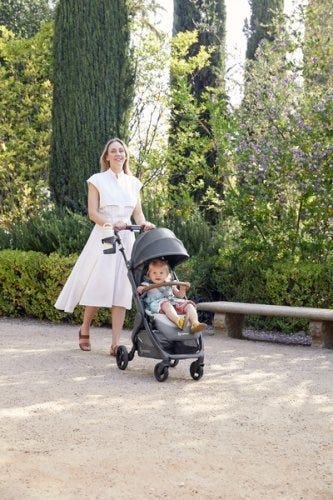

While baby carriers are fantastic for mobility and closeness, depending on the adventure of choice you might want to be a stroller along too.
There are a LOT of baby stroller options on the market. So we understand how confusing it can be to choose the one that’s right for your family. Not only are there a variety of brands, but a variety of strollers that serve different purposes.
There are a few types of strollers on the market:
- Full-sized stroller: This is typically the stroller parents thing of buying for all its versatility.
- Lightweight or umbrella stroller:These compact strollers are perfect for on-the-go adventures.
- Jogging stroller: Designed for parents who want to combine fitness with outdoor adventures.
- Double stroller: Designed for parents with multiple kids, especially twins.
- Car seat carrier: These strollers connect to a specific car seat. We don't typically recommend these as they can be unsafe for baby and uncomfortable for parents who are pushing.
Learn more about the types of strollers and which one would be best for you.
Benefits of Bringing a Stroller
- Storage Space for Gear: Ample room for carrying all your essentials like a diaper bag, beach toys and more.
- Shade and Weather Protection: Built-in canopies to shield your baby from the sun when they are lounging.
- Options: If you have more than one kid, you can stroll with one and carry the other. Or, if you’re getting warm or your little one is getting fussy, you can switch up their position from stroller to carrier or vice versa.
Safety Tips for Strollers
- Ensure your stroller is in good working condition. Make sure buckles are still buckling and that there are no rips or holes that could compromise your baby’s safety.
- Use sunshades or bug nets to protect your little one’s skin.
- Securing the baby properly: always buckle up your baby for safety even if you think they are old enough to go without the buckle.
Combining Baby Carriers and Strollers
For the ultimate flexibility, consider using both a baby carrier and a stroller on your outings.
Combining both options allows you to adapt to different situations. Use the carrier for more rugged trails and switch to the stroller for smoother paths or when your baby needs a nap.
Transition Tips
- Smooth Transitions: Plan stops where you can easily switch from carrier to stroller.
- Pack Light: Only bring essentials to make transitions easier.
Tips for a Successful Adventure
Planning Ahead
- Route Planning: Choose baby-friendly trails and parks. Check local mom groups or outdoor groups and get recommendations for the best outings for kids.
- Check Weather Conditions: Avoid extreme heat or unpredictable weather. Even with our most breathable carriers, when it’s hot, it’s hot. And having two bodies against each other in the heat will be naturally hot and sticky already.
- Packing Checklist: Include diapers, snacks, water, sunscreen, and a first-aid kit. These all-position carriers have storage pockets where you can fit some of the items easily!
- Stay Hydrated and Nourished: Pack healthy snacks to keep energy levels up and bring plenty of water for both you and baby.
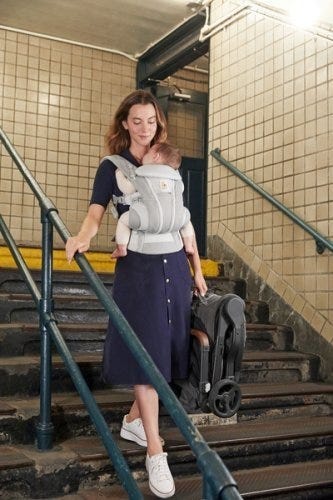

Summer adventures with your baby are a wonderful way to create lasting memories and enjoy the beauty of nature together. From baby carriers to strollers, Ergobaby products are designed to provide comfort and ease for both you and your little one. So, gear up, get outside, and explore the world with your baby by your side.
Ready to embark on your own summer adventures? Check out Ergobaby’s range of baby carriers and strollers to find the perfect match for your family’s needs. Visit our website today and start planning your next outdoor excursion!

